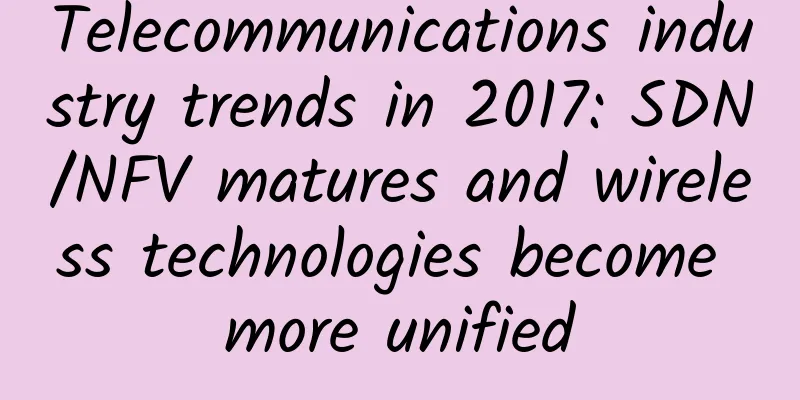Telecommunications industry trends in 2017: SDN/NFV matures and wireless technologies become more unified

|
As the old saying goes, "It's hard to predict, and even harder to predict the future." But when Brocade's network virtualization expert Benson Schliesser made this statement at this time, it undoubtedly shows that some of us in the IT industry are trying our best to "predict."
As 2016 draws to a close, we take a look back at all the important events that have happened since the beginning of the year and try to make sense of them. Then, some of us start to make our own "predictions" about industry trends in the coming year based on these events. Mistakes are inevitable, and controversy and debate are common—but that’s what makes it more fun. It is in that spirit that I wrote this article. It also proves the old saying, “You can’t get a tiger without risking it.” The Internet is everywhere In 2016, the Internet has become a ubiquitous part of most of our lives. I am not in a position to predict how this trend will continue. However, we can see some interesting details. For example, in 2017, hardware and software will continue to disaggregate, resulting in more cost-effective networks - with increased capacity and more flexible service models across an ever-expanding range of businesses. We will see advances in wireless networking technology and a subtle shift in the enterprise's stance on endpoint security. Users will more frequently connect to network resources that allow them to be most productive. Software-defined networking and network function virtualization are maturing In recent years, there has been a lot of excitement and expectations around Software Defined Networking (SDN) and Network Function Virtualization (NFV) technologies. As we headed into 2016, the industry had a solid understanding of the significant challenges in onboarding, orchestration, and control of software defined infrastructures that deliver network connectivity and services. Now, as we head into 2017, we are seeing a balance of skepticism and optimism about both technologies, indicating that we are approaching the level of maturity required to find real solutions. In 2017, we expect to see commercial launches of complete, multi-vendor software-defined network infrastructure solutions based on an ecosystem of software-defined networking and network function virtualization components. User discomfort with the limited services of proprietary platforms continues to grow. As enterprises and private data centers find a manageable path to realize the value of flexible infrastructure, adoption will surpass early adopter service providers. Wireless Technology Unification With the rapid adoption of smartphones in recent years and the consolidation of mobile operating system platforms, wireless user behavior has become better understood. At the same time, users have evolved with the times and their expectations of the network have increased accordingly. In 2017, we will begin to see the various efforts to unify local Wi-Fi and cellular mobile data networks bear fruit. Devices will roam seamlessly across the different network technologies that will be deployed by a variety of network operators. In addition, devices will begin to use multiple networks simultaneously, seamlessly moving data traffic as network connections change (due to capacity, resource connectivity, and mobility). At the same time, the next generation of wireless networks will begin to adapt to user needs by shifting capacity to where it’s needed. The new reality of wireless connectivity, which will begin to emerge in 2017, will be a nearly invisible unification of different wireless networks, and behind this unification is an always-on, high-capacity wireless user experience. In-vehicle network As more and more things connect to the internet, one of the new normals that will emerge in 2017 will be connected cars. Automakers are exploring opportunities to improve vehicle serviceability and driver convenience, but the real opportunities are only beginning to be realized. In 2017, users will begin to understand the promise of connected cars, including providing them with the ability to connect their cars and homes, share telemetry and driving conditions with nearby vehicles, and more fully integrate the driver's IT experience (such as securely integrating personal calendars, messaging applications, etc.) into the driving experience. Standardization of everything The “Internet of Things” (IoT) has been a big focus in 2016, and many of us are now aware of the promise of the connected home. Thanks to an effective blend of startups and established vendors, we can now monitor, climate-control, and secure our homes with connected devices. Our smart TVs can now work with our lighting. Our smartphones can tell the house to wake us up and start brewing coffee so we don’t miss an important online meeting—scheduled for attendees in earlier time zones… Unfortunately, some of the early adopters in 2016 also learned a painful lesson about the need for standardization and open platforms. As some vendors running proprietary cloud platforms went out of business or changed their business models, their users were left alone. We expect the IoT market to begin developing standards in 2017 to make their platforms more secure, open, and sustainable. In addition to alleviating consumer concerns, these standards will also kick-start an IoT ecosystem that is more attractive to businesses, allowing service providers to develop innovative services and support advanced use cases that exist only in our imaginations today. Blurring lines between endpoints, networks, and the cloud As networks become more flexible and software-defined, and more types of endpoints (i.e., various “things”) are added, cloud computing architectures will evolve dramatically beyond what we saw in 2016. Of course, applications on mobile devices will continue to work with centralized cloud services. But emerging technologies like mobile edge computing (MEC) will open up a world of new possibilities, such as low-power devices that leverage local computing resources in the network to conserve power, or mobile devices that use low-latency network services for self-organizing migration use cases. In 2017, the foundations of this hyper-distributed architecture will emerge, and it will have a huge impact on the future of network and application architecture. Machine Learning is Everywhere Machine learning (ML) algorithms have been studied for many years, but they exploded onto the mainstream scene in 2016. Machine learning algorithms can now be trained on all types of data, thanks to the availability of high-powered processors, “big data” collection architectures, and open source software. In 2017, expect machine learning to continue to grow in importance as a foundational technology driving innovation across industries. In the context of network technology, machine learning techniques will be used to solve problems that were previously thought to be unsolvable. The skills shortage we saw in 2016 will continue to worsen in 2017 as the industry's demand for the most talented machine learning scientists and engineers rises dramatically. Combined with software-defined networking and network function virtualization, machine learning will become a core competency for any vendor trying to build next-generation platforms for in-vehicle networks, IoT, mobile edge computing, cloud, and security. Shadow IT and Cybersecurity As consumer technology becomes more user-friendly and more powerful, enterprises are faced with an increasing amount of “Shadow IT,” where their users use their own devices, manage their own applications and data, and use their own personal collaboration tools to perform their work. Despite all the potential dangers, shadow IT continues to grow because enterprise IT cannot compete with the functionality, ease of use, and reliability of consumer services. Shadow IT has become so common that it has even become a mainstream news story in 2016, as recently discussed in the discussion about the email habits of candidates in the US presidential election. Of course, enterprise information security teams will continue to struggle with shadow IT activities, and while some organizations will attempt to legislate corporate security policies, 2017 will see the most enlightened companies recognize the hidden threats of substandard IT services. The most successful IT and information security teams will collaborate on simultaneous infrastructure modernization and security through a variety of approaches, including software-defined networking, carefully crafted network function virtualization security services, advanced encryption and identity management, cloud service integration, and differentiation of on-premises applications. Virtual and augmented reality for the web Virtual reality (VR) and augmented reality (AR) have been struggling to overcome technological limitations for decades, but 2016 was clearly their breakout year—consumer VR headsets for video game systems hit the market during the 2016 holiday season, several major smartphone brands now offer VR capabilities, and new AR systems are on the horizon. In 2017, we expect these virtual and augmented reality systems to focus primarily on entertainment and education, but as these platforms mature—mid to late 2017—experimental applications of these technologies are expected in communications, data visualization, and enterprise situational awareness. Salute to Tomorrow As we bid farewell to 2016, we turn our attention to the future that awaits us. In fact, in the past year, we have accepted many technologies that were once thought to be in the future, and we have also seen many mature technologies become the background of development after full popularization. We are entering 2017, a year full of new challenges and opportunities, which is daunting but also exciting. And the new year is full of infinite possibilities, isn't it? |
Recommend
Without 5G performance guarantees, can operators fully exploit this opportunity?
Private 5G networks are attractive to the largest...
2021 China Internet Haha List 3: Top Ten Keywords
With change comes new opportunities. The Internet...
What other issues do we need to address to grow our business?
Consumers in today's world are more "fic...
Don’t rush to fight for 5G
Recently, discussions about 5G have been everywhe...
China Telecom Tianyi Cloud 3.0 helps Heizi Technology build Zhongshan intelligent cloud platform
In May 2015, the state released the "Made in...
Video and Network - Why is 700MHz the golden channel?
Labs Guide 700M is called the "golden freque...
Seven key developments for SD-branch in 2020
In the next few years, the connection of remote b...
Megalayer: VPS hosting 50% off, 189 yuan/year, cloud server/high-defense server 60% off, Hong Kong/Singapore/US/Philippines data centers
Megalayer has released the 2024 New Year's Da...
5G modem and processor shipments surge
[[389359]] Data from the Global Mobile Suppliers ...
NB-IoT is here! The network is only two months away from being launched, but the chips and platform are ready
With the opening of emerging markets such as wear...
[11.11] Megalayer: US server 99 yuan/month, Hong Kong server 199 yuan/month, Hong Kong/US VPS monthly payment 9.9 yuan
Megalayer released a promotional plan for this ye...
Learn more! The principles behind Wi-Fi revealed!
Wi-Fi and 4G/5G cellular networks are the two mos...
The biggest problem with 5G: not the technology, but the lack of “killer applications”
The global 5G progress forecast released by Credi...
China Mobile Selects Brocade NFV Software Appliance to Support "Internet+" Mission
Mobile giant will break new ground in China's...
China Mobile actively promotes the accelerated implementation of 5G innovative applications
On September 20, China Mobile held the 5G+ Innova...









